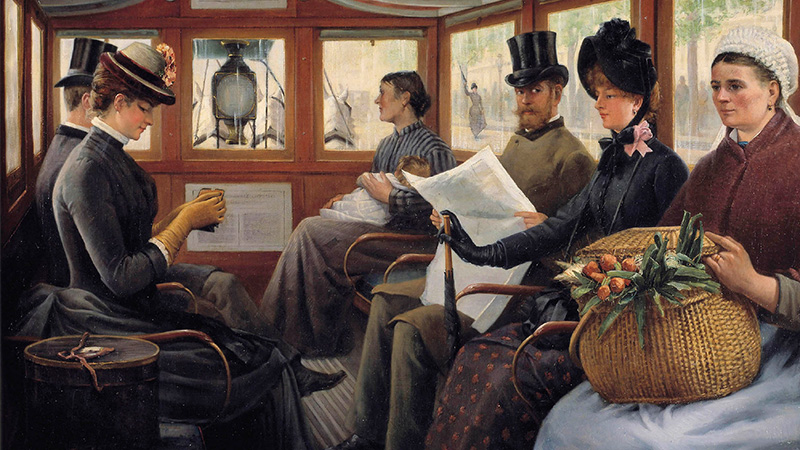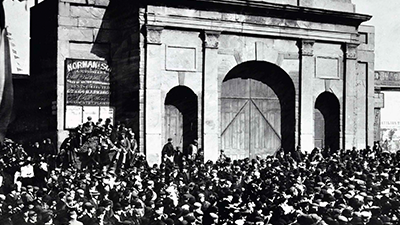The Division of Labor
Teacher Resources
Driving Question: How did industrialization drive the evolution of class identity?
Factories didn’t just divide jobs, they divided people. As labor became more specialized, the line between the workers and those with power became harder to cross.
Learning Objectives:
- Learn about the impact of new economic theories and the creation of the modern system of social classes.
- Use the historical thinking practices of comparison and causation to analyze why people demanded reforms in this era.
- Use a graphic biography to support, extend, or challenge the overarching narratives of this period.
Vocab Terms:
- bourgeoisie
- capitalism
- industrial capitalist
- proletariat
- reform
- social class
- union
Opener: The Division of Labor
To teach this lesson step, refer to page 2 of the Lesson 4.3 Teaching Guide.
In this lesson, you’re going to learn about how industrialization transformed class dynamics. Zooming in on the lives of several individuals will help you understand the human impacts of these big changes.
The Working Class
To teach this lesson step, refer to page 4 of the Lesson 4.3 Teaching Guide.
The Assembly Line Simulation is a great hands-on activity. Read about how other teachers have approached this activity in the Community Forum.
These materials show how industrialization changed both factory work and social class, helping us understand the growing divide between groups.
-
Guiding Questions
-
Before you read
Preview the questions below, and then skim the article. Be sure to look at the section headings and any images.
While you read
Look for answers to these questions:
- What were the two main social classes affected by industrialization? How did the lives of people in those classes change?
- What does it mean to say that class is a social construct?
- What was daily life like for the urban proletariat during the long nineteenth century?
- How did the middle class see the working class? How did that affect how they saw themselves?
- What did Karl Marx believe about the relationship between the classes and what would eventually happen?
After you read
Respond to these questions: Do you think the article presents an overly simple view of class differences? In addition to class, what factors might shape someone’s experience?
Labor Reforms
To teach this lesson step, refer to page 7 of the Lesson 4.3 Teaching Guide.
Looking for supports to scaffold articles for your students? Pages 3-5 of the OER Project Reading Guide provides a wealth of ideas.
Industrialization pushed people to fight for change. This article and graphic biography will help you explore how class identity shaped reform efforts and how people challenged the system from within.
-
Guiding Questions
-
Before you read
Preview the questions below, and then skim the article. Be sure to look at the section headings and any images.
While you read
Look for answers to these questions:
- What inspired many reformers in the United States and Britain during the long nineteenth century?
- How did Mott and Stanton’s abolition work lead to their fight for women’s rights?
- What reforms followed the Triangle Shirtwaist Factory fire?
- What did Upton Sinclair reveal in The Jungle? What impact did it have?
- What kinds of reforms were made to improve children’s lives during this period?
After you read
Respond to these questions: The author describes two very different social classes in the nineteenth century. Do you think their lives were really that separate? What might be missing from this story?
-
Guiding Questions
-
Before you read
Preview the questions below, and then skim the comic, paying attention to things like prominent colors, shapes, and types of text and fonts. How do you know where to start and in which direction to read? What’s in the gutters (the space between panels)? Who or what is the focus of the comic?
While you read
- When was Ottilie Baader born? What did she learn when she first started school?
- Why did Baader start working? What was her life like at that time?
- Describe Baader’s work experience at the wool factory.
- What made Ottilie Baader want to become a labor organizer?
- How does the graphic biography’s artwork show both Baader’s factory life and her efforts to change it?
After you read
Respond to this question: How does Ottilie Baader’s story support or challenge what you’ve learned about the impact of industrialization?
Closer: The Division of Labor
To teach this lesson step, refer to page 9 of the Lesson 4.3 Teaching Guide.
Wanting to include more women in history class? This thread, How do you include women in the story? is full of ideas!
Read a graphic biography about an industrial worker and consider how she would reflect on the changes of the Industrial Revolution.







